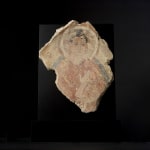Gandharan Fragment of a Fresco Depicting the Buddha, 200 CE - 400 CE
Fresco
21.6 x 26.4 cm
8 1/2 x 10 3/8 in
8 1/2 x 10 3/8 in
LO.1309
Further images
Sizeable fresco fragment with polychrome decoration against tan slip; a youthful Buddha is shown fully frontally with nimbus formed of stripes of different width and colours emanating behind head; wears...
Sizeable fresco fragment with polychrome decoration against tan slip; a youthful Buddha is shown fully frontally with nimbus formed of stripes of different width and colours emanating behind head; wears heavy outer robe -sa?ghati- and holds right hand with fingers tensed and palm turned inwards to left breast; head faces slightly to the right and bears typical features including heavy-lidded, almond eyes beneath high, arched brow, slender triangular nose and small, full-lipped mouth; the earlobes are classically sagging and typical elevation of force in the middle of his skull known as a ushnisha is present; his body is framed by a mandorla formed of a thick blue stripe.
Buddhism took a hold of Gandhara – a tract of country on the west bank of the Indus River that comprises the Peshawar Valley and the modern Swat, Buner and Bajaur – during 3rd century BCE. The earliest examples of Buddhist sculpture were produced at this time, however rather than being in the image of Buddha they recounted episodes from his life, intending to glorify him. By 1st century BCE Gandharan art had come into being and by 3rd century ACE, the School of Gandhara had initiated and established not only the practice of portraying the Buddha in bodily form but also, a distinct and uncompromising set of strictures to which these images must abide. The facial features, extended ear lobes – caused by discarding the heavy gold earrings appropriate to Buddha’s warrior class upon leaving home towards enlightenment, ushnisha and gesture (mudra) are part of a distinct physiognomy and readily identify Buddha. Other features however attest influence across a wider geographical area. For example, the hairstyle relates to Chinese imagery and the mandorla – traditionally an almond-shaped aureole of light surrounding a holy figure – appears in Christian art as a standard attribute of Christ. Furthermore, Buddha’s rather ample visage speaks more of classical influence. The conquest of Alexander the Great during 4th century BCE and influx of Hellenistic art, while short-lived, left an enduring mark on the nascent School of Buddhist sculpture. There was an incredible surge in the output of Buddhist images, western aesthetics became prominent and images of Buddha based on Greco-Roman models. While, orthodox elements of the classic Buddhist iconography did endure and remain little changed over centuries, with such a long history of foreign occupation since its first appearance in the historical sources during 9th century BCE – under Persian rule until the conquest of Alexander the Great between 327-326 BCE, and thereafter intermittently between a succession of foreign powers until once again falling under Persian helm in 3rd century ACE – it is not surprising that the changes in the socio-economic and political landscape gave rise to shifts in the arts. Gandharan murals and wall paintings have scant survived.
Buddhism took a hold of Gandhara – a tract of country on the west bank of the Indus River that comprises the Peshawar Valley and the modern Swat, Buner and Bajaur – during 3rd century BCE. The earliest examples of Buddhist sculpture were produced at this time, however rather than being in the image of Buddha they recounted episodes from his life, intending to glorify him. By 1st century BCE Gandharan art had come into being and by 3rd century ACE, the School of Gandhara had initiated and established not only the practice of portraying the Buddha in bodily form but also, a distinct and uncompromising set of strictures to which these images must abide. The facial features, extended ear lobes – caused by discarding the heavy gold earrings appropriate to Buddha’s warrior class upon leaving home towards enlightenment, ushnisha and gesture (mudra) are part of a distinct physiognomy and readily identify Buddha. Other features however attest influence across a wider geographical area. For example, the hairstyle relates to Chinese imagery and the mandorla – traditionally an almond-shaped aureole of light surrounding a holy figure – appears in Christian art as a standard attribute of Christ. Furthermore, Buddha’s rather ample visage speaks more of classical influence. The conquest of Alexander the Great during 4th century BCE and influx of Hellenistic art, while short-lived, left an enduring mark on the nascent School of Buddhist sculpture. There was an incredible surge in the output of Buddhist images, western aesthetics became prominent and images of Buddha based on Greco-Roman models. While, orthodox elements of the classic Buddhist iconography did endure and remain little changed over centuries, with such a long history of foreign occupation since its first appearance in the historical sources during 9th century BCE – under Persian rule until the conquest of Alexander the Great between 327-326 BCE, and thereafter intermittently between a succession of foreign powers until once again falling under Persian helm in 3rd century ACE – it is not surprising that the changes in the socio-economic and political landscape gave rise to shifts in the arts. Gandharan murals and wall paintings have scant survived.











